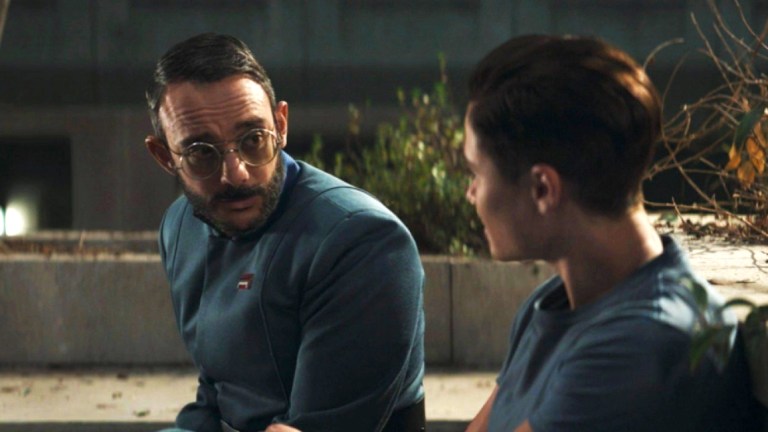The Mandalorian Just Proved the New Republic Isn’t Much Better Than the Empire
Elia Kane and Dr. Pershing show us the dark side of the New Republic in Star Wars: The Mandalorian.

This Star Wars article contains spoilers for The Mandalorian.
It’s the dawn of a new age on Coruscant, as The Mandalorian season 3 revisits the familiar locale but under different management. As the center of the Star Wars galaxy during the Prequel era, at the height of the Empire’s rule, and five years after Return of the Jedi, the city planet has gone through several seismic cultural shifts from one regime to the next. As you might expect, with the fall of the Empire happening between Andor and The Mandalorian, things have changed quite a lot since Mon Mothma was defending the Ghormans.
While the darkness of the Empire has slunk back into the shadows, largely relegated to the Outer Rim planets, the New Republic now reigns supreme on Coruscant. But in The Mandalorian season 3 episode “The Convert,” we learn from returning characters Dr. Penn Pershing (Omid Abtahi) and Elia Kane (Katy O’Brian) that Coruscant and the surrounding galaxy might not be that much better off now that the Empire’s been sent packing.
Until now, the New Republic had existed largely in the periphery of the Mandoverse, although Disney has long teased that it would eventually delve deeper into it. Cameo appearances by space cops Carson Teva and Trapper Wolf in The Mandalorian, as well as Cara Dune’s decision to become a New Republic marshal, seemed to be setting up the Rangers of the New Republic spinoff series. But after Disney parted ways with Gina Carano, the show was quietly shelved.
Lucasfilm president Kathleen Kennedy suggested to Empire magazine (via IGN) that the planned Rangers storylines would be “absorbed” into The Mandalorian, and now, we get a sense of how the New Republic fits into things. Although the formal government born from the Rebellion is supposed to be the antithesis of the Empire, Rogue One and Andor have both shown that even the good guys sometimes use some less than savory methods to accomplish their goals.
What Is the New Republic?
The Mandalorian’s place in the convoluted Star Wars timeline means season 3 takes place about a decade after the Battle of Yavin in A New Hope — although showrunner Jon Favreau has since muddled things with unclear answers about how long Grogu trained with Luke Skywalker. We’re just going to ignore his “many years” comment for the moment because it doesn’t quite add up. For our purposes, we’re just going to assume everything that’s happened on The Mandalorian takes place in 9 ABY (nine years after A New Hope and five after Return of the Jedi).
Effectively restoring the Galactic Republic, the New Republic was officially formed in 5 ABY, just a year after the Rebellion’s victory at the Battle of Endor in Return of the Jedi. So when we catch up with Pershing and Kane on Coruscant, the galactic government is still in its early days and clearly over-extended, which is why Pershing spends so much of his time talking to droids instead of real people at the New Republic amnesty office.
While we only really see the government at ground level in The Mandalorian, there are a lot of bigger things going on from a galactic scale. The New Republic wants to take a very different approach to the Empire as the major ruling faction, and has put several policies in place that to separate itself from what came before. For example, instead of simply adopting Coruscant as its capital, the New Republic rotates its seat of power, starting with Mon Mothma’s homeworld of Chandrila.
At the time of The Mandalorian, Mothma is serving as the first Chancellor of the New Republic, and while she’s working to dismantle the Imperial Fleet in the Coruscant shipyards, one of her most divisive policies also involves decommissioning the Rebel Alliance Fleet. Mothma believes a demilitarized galaxy will prolong the hard-earned peace, but her policies essentially leave the more modest New Republic Defense Force without any real teeth to defend the government from attack. Surely, no one will regret this down the line. No way.
Over two decades after the events of “The Convert,” the New Republic will ultimately unravel because it doesn’t take the threat of the First Order seriously. In The Force Awakens, which takes place in 34 ABY, we watch as the First Order uses Starkiller Base to obliterate the New Republic capital on Hosnian Prime, effectively bringing the government to a fiery end. Only General Leia Organa’s Resistance is left to defend the citizens of the galaxy from a resurgent Empire.
In a 2019 interview, Favreau promised EW that The Mandalorian would show the rise of the First Order and bridge the gap between the Original and Sequel Trilogies. Now, the pieces are starting to come together, and we’re learning that the fall of the New Republic really begins from within its own borders. As one affluent and apathetic Coruscant resident tells Pershing in the latest episode, “Empire, Rebels, New Republic, I can’t keep track.” To be honest, neither can we. To a degree, they’re starting to look like extensions of each other.
Is the New Republic Any Better Than the Empire?
“The Convert” is the first time we really get to explore Coruscant during the New Republic era, and it honestly doesn’t look much fun to live there. The New Republic prides itself on avoiding the Empire’s xenophobia, but underneath all the celebrations of Benduday (Friday) and Dr. Pershing enjoying glowing ice lollies with Elia Kane, it has a similarly controlling grip on its citizens.
We learn how some of those who served the Empire have been reintegrated into society as part of the Amnesty Program. In reality, the Amnesty Program seems to be a cushy prison for those former Imperials the New Republic deems as valuable. Because Pershing is a brilliant scientist, he’s a shoe-in for the Amnesty Program, but once he’s welcomed back to Coruscant, it becomes very clear the New Republic doesn’t actually intend to let him live as a free citizen in this new “utopia.”
Pershing’s only allowed to visit certain places on Coruscant and has to regularly check-in with what amounts to a droid parole officer. He’s not allowed to really choose what role he wants to play in this new society, and is relegated to a mind-numbing desk job helping dismantle Imperial equipment rather than continue his research into cloning. Although his true intention is to use cloning to make advancements in medicine that could save millions, that research is strictly forbidden by the New Republic (which, fair enough, since it was a clone army that Palpatine initially used to destroy the Jedi and subjugate the galaxy).
Notably, Dr. Pershing’s new life under the New Republic mirrors the mundane side of the galaxy fans loved so much in Andor — in particular, the parallels between Pershing’s low-level job archiving Imperial technology and the shamed Syril Karn working at the Imperial Bureau of Standards filing reports. Like the Empire, the New Republic is very into its bureaucratic systems, surveilling, documenting, and red tape, as Pershing learns when he suggests he could show his bosses how to use Imperial tech for good. The Doctor’s menial position eventually leads him to question whether he’s actually contributing anything valuable to society, or if he’s just meant to live out the rest of his days following orders blindly in service of the New Republic, just as he did when under the employ of the Empire.
Whether Pershing was coerced into working for the Empire or not, he reveals in his speech at the opera house how organ cloning could’ve saved his mother from a disease, which led to the belief his work could be used for good…in the right hands. But while seemingly against cloning for now, the New Republic isn’t above using other dangerous Imperial technology when the situation calls for it.
They employ a grotesque procedure with a machine called the Mind Flayer to torture “soothe” and “recalibrate” Pershing’s mind. Yes, it’s Kane who later turns the knob all the way up to torture when her superiors aren’t looking, but the fact that the New Republic uses electroshock therapy on its prisoners at all is a terrible look. When the Mon Calamari technician says he’s undergone the treatment himself, it makes you wonder whether he’s also a former Imperial sympathizer who was brainwashed into obeying the New Republic.
It all turns out to be very dystopian in the end, with Dr. Pershing, strapped up in a room by the very government that promised to give him a better life as long as he followed all the rules blindly and played his part in the New Republic’s plans. The Amnesty Program claims to be all about rehabilitation but essentially uses Kane to encourage Pershing to “relapse” in order to test his true allegiance and force him to obey. Sounds like something the Empire would do, doesn’t it?
The Mandalorian season 3 streams on Wednesday on Disney+.
